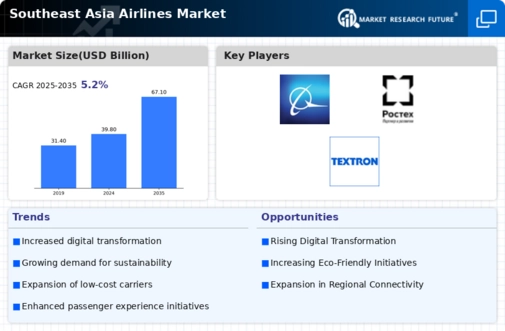Tourism Growth
Tourism plays a pivotal role in the Global Southeast Asia Airlines Market Industry, with countries such as Thailand and Malaysia being popular destinations for international travelers. The region's diverse attractions, ranging from cultural heritage sites to natural wonders, continue to draw millions of tourists annually. In 2024, the market is anticipated to benefit from this influx, as airlines expand their routes and services to accommodate growing tourist numbers. The tourism sector's contribution to GDP in Southeast Asia is substantial, and as travel becomes more accessible, the airlines are poised to capitalize on this trend, further solidifying their market presence.
Government Initiatives
Government initiatives aimed at enhancing aviation infrastructure are crucial drivers of the Global Southeast Asia Airlines Market Industry. Investments in airport expansions and upgrades are being made across the region, facilitating increased air traffic and improved connectivity. For example, the expansion of major airports in Singapore and Bangkok is expected to accommodate larger volumes of passengers and cargo. These initiatives not only enhance the travel experience but also stimulate economic growth through job creation and increased tourism. As these developments unfold, they are likely to bolster the market's growth, contributing to a projected CAGR of 4.86% from 2025 to 2035.
Market Growth Projections
The Global Southeast Asia Airlines Market Industry is projected to experience substantial growth in the coming years. With a market size expected to reach 39.8 USD Billion in 2024 and further expand to 67.1 USD Billion by 2035, the industry is on a promising trajectory. The anticipated compound annual growth rate (CAGR) of 4.86% from 2025 to 2035 indicates a robust demand for air travel in the region. This growth is likely to be fueled by various factors, including increased tourism, rising disposable incomes, and government support for aviation infrastructure. Airlines are expected to adapt their strategies to capitalize on these trends, ensuring sustained growth.
Technological Advancements
Technological advancements are reshaping the Global Southeast Asia Airlines Market Industry, enhancing operational efficiency and customer experience. Innovations such as advanced booking systems, mobile applications, and in-flight entertainment systems are becoming standard. Airlines are increasingly adopting these technologies to streamline operations and improve passenger satisfaction. For instance, the integration of artificial intelligence in customer service and flight management systems is expected to optimize resource allocation and reduce costs. This technological evolution is likely to support the market's growth trajectory, with projections indicating a market size of 67.1 USD Billion by 2035, reflecting the industry's adaptability to changing consumer preferences.
Rising Middle-Class Population
The Global Southeast Asia Airlines Market Industry is experiencing growth driven by the rising middle-class population in the region. As disposable incomes increase, more individuals can afford air travel, leading to a surge in demand for both domestic and international flights. For instance, countries like Indonesia and Vietnam are witnessing significant growth in their middle-class segments, which is projected to expand by millions over the next decade. This demographic shift is likely to contribute to the market's valuation, which is expected to reach 39.8 USD Billion in 2024, indicating a robust potential for airlines to cater to this expanding customer base.
Environmental Sustainability Efforts
The Global Southeast Asia Airlines Market Industry is increasingly influenced by environmental sustainability efforts. Airlines are adopting greener practices, such as investing in fuel-efficient aircraft and implementing carbon offset programs. This shift is driven by both regulatory pressures and consumer demand for sustainable travel options. For instance, several airlines in the region are committing to reducing their carbon footprints, which may enhance their brand image and attract environmentally conscious travelers. As sustainability becomes a priority, the market is likely to evolve, with airlines that prioritize eco-friendly practices potentially gaining a competitive edge in the growing market.














Leave a Comment